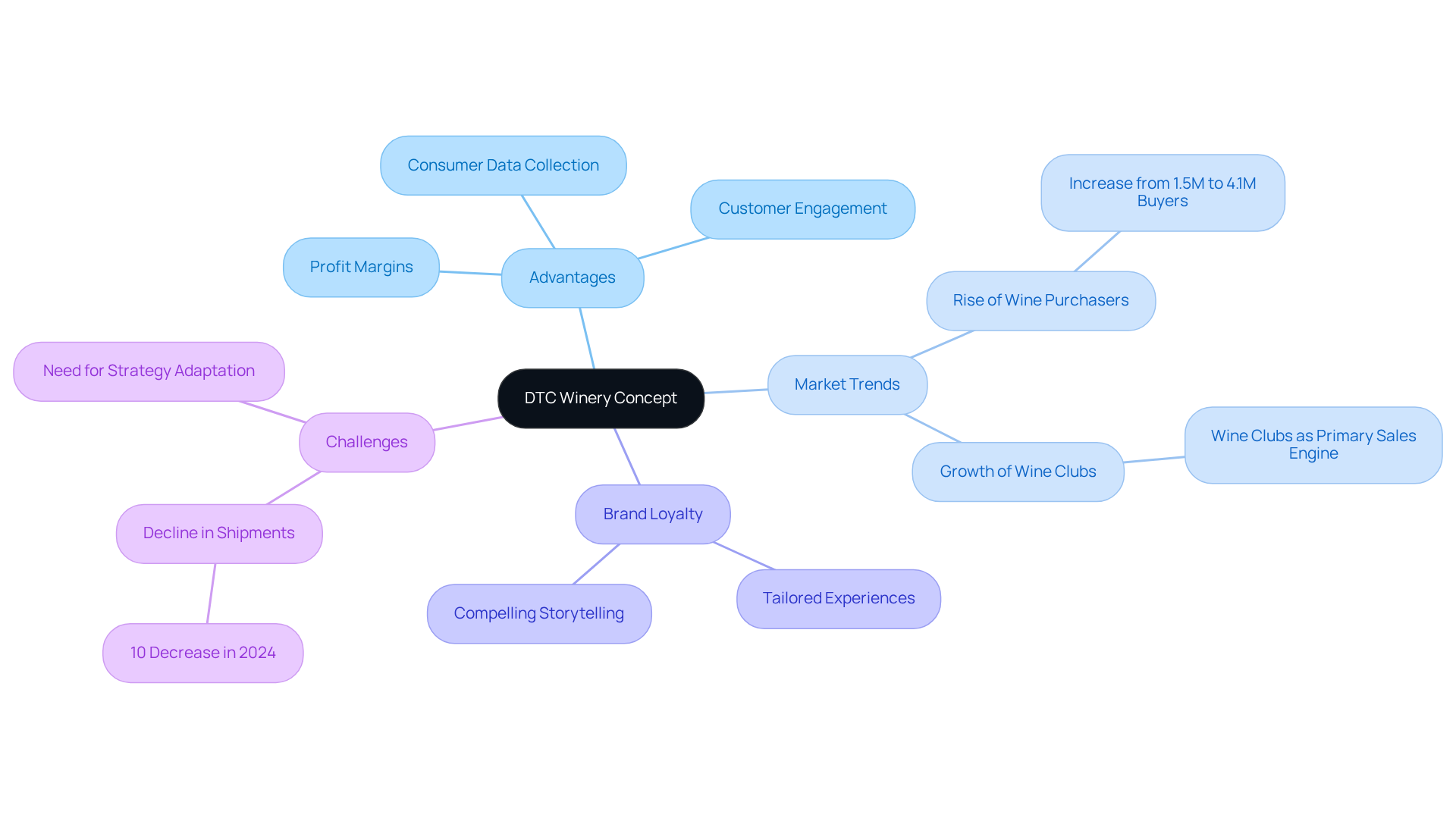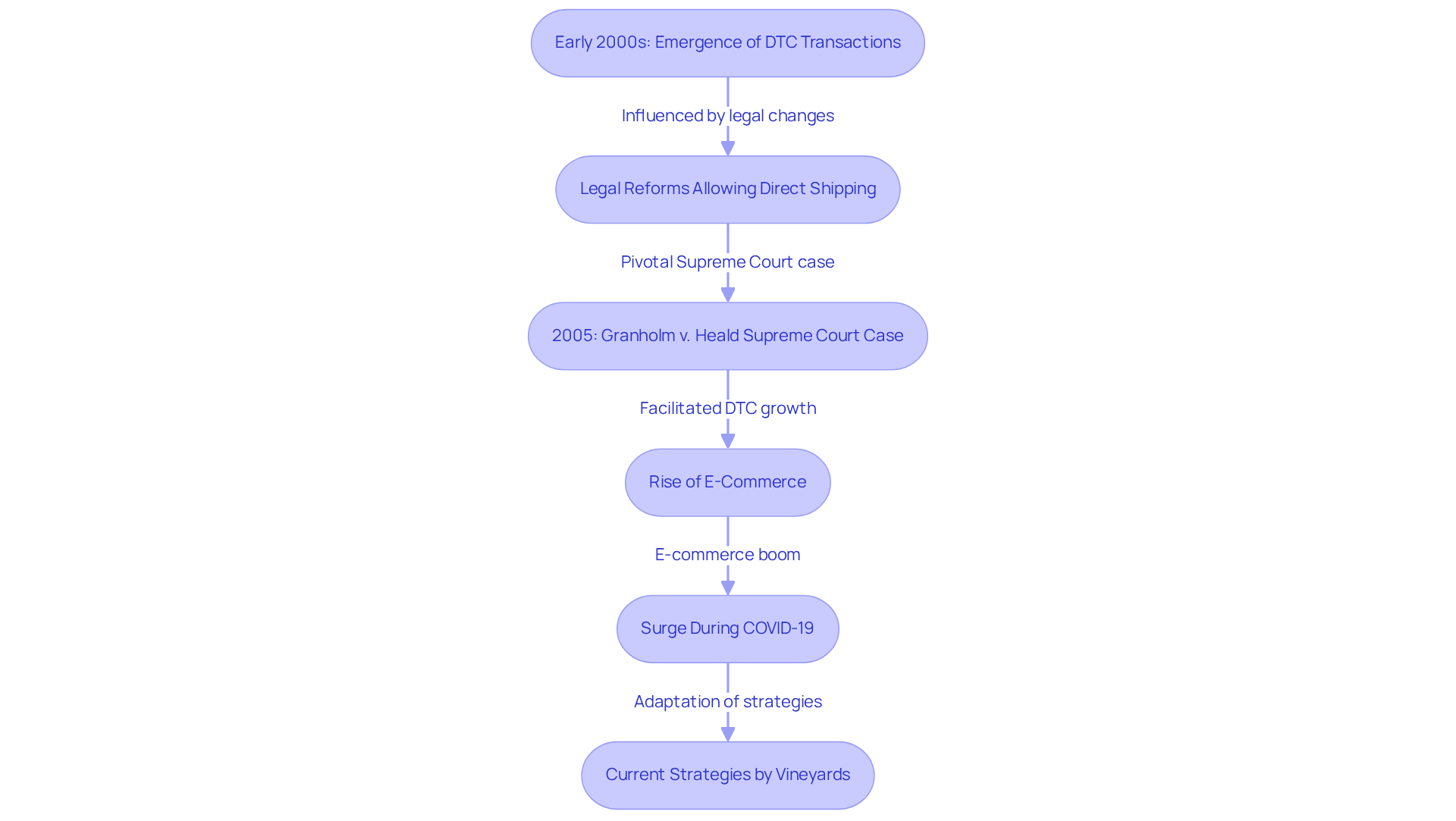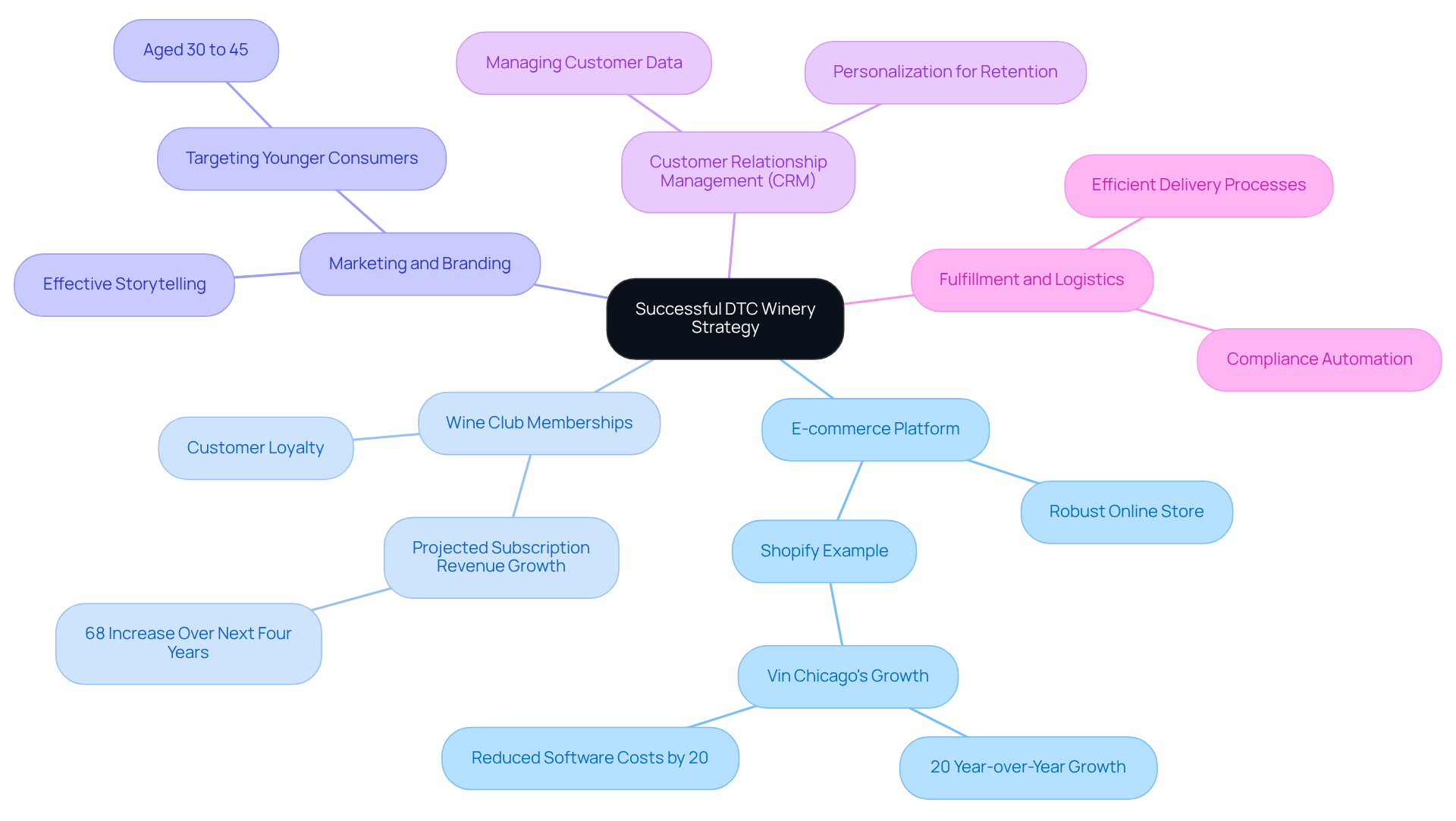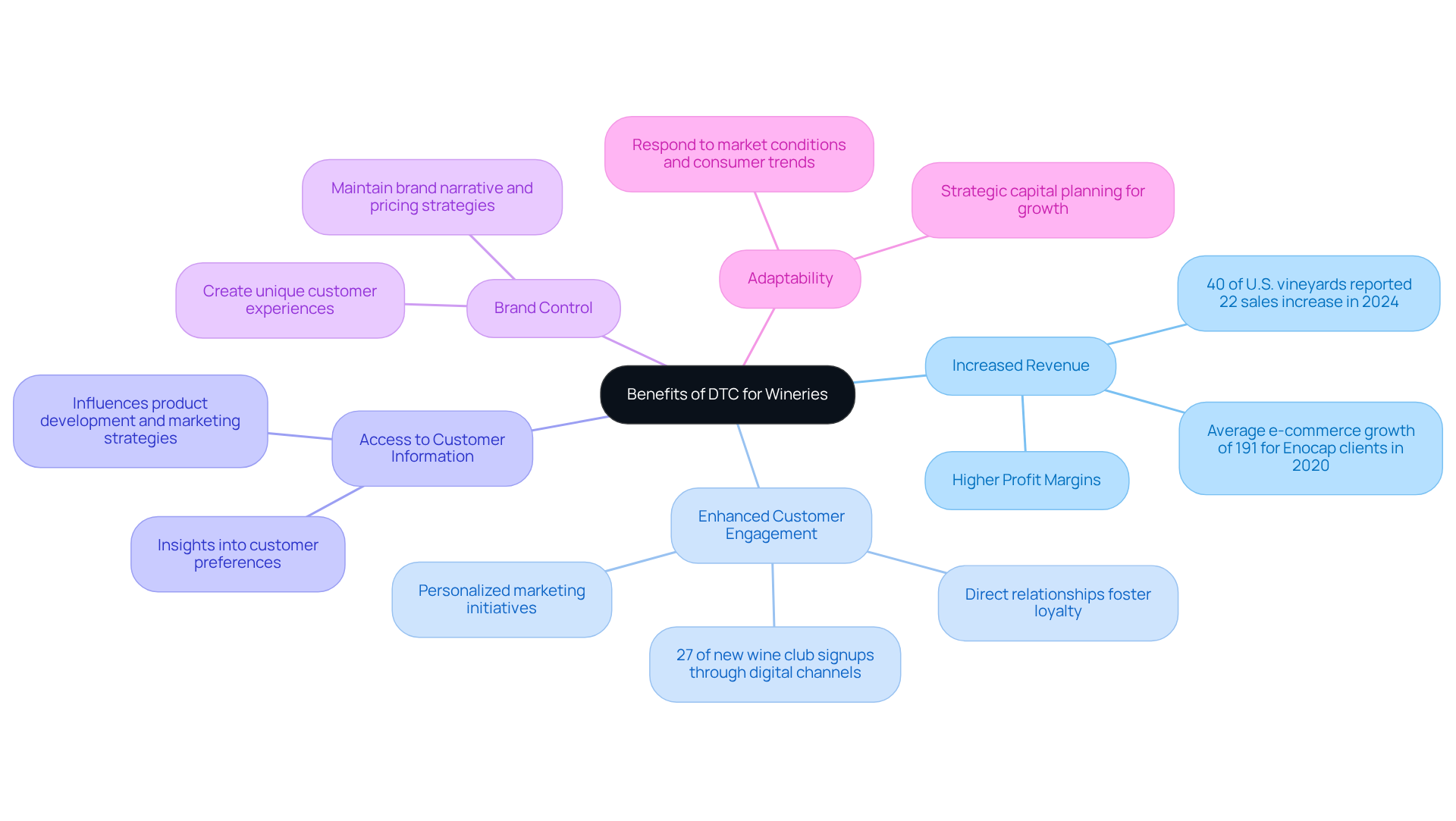Overview
A successful Direct-to-Consumer (DTC) winery strategy hinges on several key components:
- A robust e-commerce platform
- Wine club memberships
- Effective marketing and branding
- Customer relationship management
- Efficient fulfillment processes
These elements are not merely beneficial; they are essential for enhancing revenue, fostering customer loyalty, and enabling wineries to adapt to market changes. The evidence is compelling: vineyards that have successfully implemented DTC strategies report significant increases in profitability and customer engagement. By embracing these strategies, wineries position themselves for sustained growth in an increasingly competitive landscape.
Introduction
The wine industry is experiencing a transformative shift as an increasing number of wineries embrace the Direct-to-Consumer (DTC) model, which enables them to connect with customers in unprecedented ways. This innovative approach not only enhances profitability but also fosters deeper relationships with consumers, allowing wineries to craft personalized experiences that truly resonate.
However, as the market continues to evolve, challenges remain, prompting a critical question: how can wineries effectively navigate the complexities of DTC sales to ensure sustained growth and customer loyalty?
By exploring the key components and benefits of a successful DTC winery strategy, we uncover crucial insights for producers aiming to thrive in this competitive environment.
Define DTC Winery: Understanding the Concept and Its Importance
Direct-to-Consumer (DTC) establishments engage directly with consumers, bypassing conventional distribution routes such as wholesalers and retailers. This model fosters a direct relationship with customers, enhancing brand loyalty and delivering a personalized experience. The significance of direct-to-consumer transactions has surged in recent years, as producers strive to improve profit margins and exert greater control over their branding and customer interactions. By selling directly, vineyards can collect valuable consumer data, guiding their marketing strategies and product offerings.
The advantages of DTC winery transactions are particularly evident in the wine sector, where DTC wineries adopting this approach have reported substantial improvements in profitability. For instance, Enocap clients experienced an average e-commerce increase of 191% in 2020, alongside a rise in online wine purchasers from 1.5 million to 4.1 million. This growth underscores the potential of DTC transactions to enhance profit margins and customer engagement.
Moreover, establishments implementing DTC strategies can cultivate brand loyalty through tailored experiences and compelling storytelling. The emergence of wine associations as a primary DTC winery revenue source has transformed how producers connect with customers, fostering greater involvement and loyalty. As Paul Mabray, CEO of Pour Now, observes, "The major trend over the past several years has been the emergence of wine clubs as the primary sales engine for the DTC winery market."
However, it is crucial to recognize the challenges within the current market landscape, as the total volume of direct-to-consumer wine shipments fell to 6.4 million cases in 2024, marking a 10% decrease from 2023. This trend highlights the need for vineyards to to maintain consumer interest and secure appropriate funding for expansion opportunities.
In summary, the DTC winery model not only empowers producers to optimize their profit margins but also enables them to forge enduring relationships with consumers, ultimately driving sustainable growth in a competitive market.

Trace the Evolution of DTC Sales in the Wine Industry
The emergence of DTC winery transactions in the wine sector began in the early 2000s, significantly influenced by legal reforms that allowed producers to ship products directly to consumers. A pivotal moment came with the Supreme Court case, Granholm v. Heald, decided in 2005, which affirmed the rights of vineyards to distribute across state lines, thereby transforming the commerce landscape.
Following this landmark decision, the DTC winery model gained traction, propelled by the rise of e-commerce and shifting consumer preferences towards online shopping. As a result, DTC winery transactions have become a vital component of overall wine revenue, with many vineyards experiencing substantial growth in their direct revenue streams. This trend was particularly amplified during the COVID-19 pandemic, which catalyzed a surge in online shopping, further entrenching the significance of DTC strategies within the wine industry.
Today, vineyards are continually adapting to these evolving dynamics, harnessing to enhance their market presence and create deeper connections with consumers. Enocap's innovative strategies for the DTC winery empower family-owned vineyards to cultivate sustainable direct-to-consumer channels that not only facilitate consistent growth but also transform casual buyers into devoted club members through compelling brand storytelling and strategic capital planning.

Identify Key Components of a Successful DTC Winery Strategy
A successful DTC winery strategy includes several key components that are essential for thriving in today’s competitive market.
- E-commerce Platform: At the core of any successful strategy is a robust online store that facilitates direct sales. A user-friendly, mobile-optimized platform capable of handling various payment methods is crucial. For instance, Shopify has proven effective, enabling vineyards to streamline operations and enhance customer experiences. A notable example is Vin Chicago, which achieved a remarkable 20% year-over-year growth after transitioning to Shopify, underscoring the impact of a unified e-commerce solution.
- Wine Club Memberships: Developing a wine club is another critical component that fosters customer loyalty while providing a steady revenue stream. By offering exclusive releases and personalized experiences, wineries can significantly enhance the appeal of their memberships. The subscription revenue in the wine sector is projected to rise considerably, presenting a prime opportunity for producers to capitalize on this growing trend.
- Marketing and Branding: Effective storytelling and branding are vital for establishing a connection with consumers. Wineries should leverage social media, email marketing, and content marketing to engage their audience effectively. Innovative marketing strategies targeting younger consumers, particularly those aged 30 to 45, have shown considerable promise in enhancing engagement and driving sales.
- Customer Relationship Management (CRM): Implementing a DTC-focused CRM system is essential for managing customer data, tracking interactions, and tailoring marketing efforts to individual preferences. This level of personalization is crucial for building lasting relationships and increasing customer retention.
- Fulfillment and Logistics: Finally, efficient fulfillment processes are paramount for ensuring timely delivery and customer satisfaction. Wineries must adeptly navigate shipping regulations and logistics to optimize their operations as a DTC winery. Utilizing platforms that can significantly alleviate these burdens, allowing producers to concentrate on growth and enhancing the customer experience.

Explore the Benefits of DTC for Wineries: Revenue Growth and Customer Engagement
The adoption of a DTC winery sales model presents numerous advantages for wineries that cannot be overlooked.
- Increased Revenue: Bypassing intermediaries allows wine producers to secure higher profit margins. DTC winery transactions typically yield margins significantly greater than those from conventional retail avenues, thereby enhancing overall financial well-being. In fact, 40% of U.S. vineyards reported an average sales increase of 22% in 2024, underscoring the financial benefits of this model. Enocap's expertise in unlocking DTC winery revenue further supports this growth, ensuring family vineyards thrive for generations.
- Enhanced Customer Engagement: DTC empowers producers to cultivate direct relationships with their customers, fostering loyalty and encouraging repeat business. Tailored marketing initiatives can lead to heightened customer satisfaction and retention rates. Enocap employs proven strategies to transform casual buyers into loyal club members, enhancing customer engagement through personalized experiences and targeted communications.
- Access to Customer Information: Through direct-to-consumer transactions, vineyards gain valuable insights into customer preferences and behaviors. This data is essential for influencing product development, enhancing marketing strategies, and optimizing inventory management, enabling producers to craft engaging brand narratives that resonate with their audience.
- Brand Control: Direct sales grant DTC wineries the ability to maintain control over their brand narrative and pricing strategies. They can create unique customer experiences that align with their brand values and storytelling, which is crucial for establishing a sustainable DTC channel.
- Adaptability: The DTC model empowers wine producers to swiftly respond to evolving market conditions and consumer trends, ensuring competitiveness in a rapidly changing industry. Enocap's strategic capital planning enhances this adaptability by identifying opportunities for debt, equity, or acquisition, allowing businesses to navigate challenges effectively.
Statistics highlight the impact of the DTC winery model on revenue expansion, with numerous vineyards reporting substantial increases in their transactions. For instance, DTC wineries that adopted DTC strategies experienced an average e-commerce increase of 191% in 2020, showcasing the financial advantages of this approach. Furthermore, the subscription economy continues to grow, with wine subscriptions projected to reach $3.9 billion by 2033. The number of online wine purchasers surged from 1.5 million to 4.1 million, emphasizing the expanding market opportunity for DTC winery transactions. As Alex Koral, regulatory general counsel for Sovos ShipCompliant, remarked, "Direct-to-consumer has been one of the most resilient parts of the wine market." Wineries that can position themselves for sustained growth and success.

Conclusion
The DTC winery model stands as a transformative approach for wine producers, facilitating direct connections with consumers and circumventing traditional distribution channels. This strategy not only enhances profit margins but also cultivates enduring relationships with customers, ultimately driving sustainable growth in a competitive market.
Key insights from the article underscore the evolution of DTC sales, the essential components of a successful strategy, and the myriad benefits this model offers. From the substantial revenue growth reported by wineries to the increased customer engagement and brand control, the advantages of adopting a DTC approach are unmistakable. The significance of e-commerce platforms, effective marketing, and customer relationship management cannot be overstated; these elements are crucial for thriving in today’s dynamic wine industry.
Reflecting on the broader implications, the DTC winery model transcends mere trend status; it is a vital component of a winery's future success. As the market continues to evolve, embracing direct-to-consumer sales will be essential for wineries aiming to adapt and flourish. Producers are encouraged to leverage the insights and strategies discussed to enhance their operations, engage more deeply with their customers, and ultimately secure their place in the ever-changing landscape of the wine industry.
Frequently Asked Questions
What is a DTC winery?
A DTC winery, or Direct-to-Consumer winery, engages directly with consumers, bypassing traditional distribution methods such as wholesalers and retailers. This model enhances brand loyalty and provides a personalized experience for customers.
Why is the DTC model significant for wineries?
The DTC model is significant because it allows wineries to improve profit margins, maintain control over their branding and customer interactions, and collect valuable consumer data to inform marketing strategies and product offerings.
What advantages do DTC wineries experience?
DTC wineries often report substantial improvements in profitability. For example, Enocap clients saw an average e-commerce increase of 191% in 2020, and the number of online wine purchasers grew from 1.5 million to 4.1 million.
How do DTC strategies foster brand loyalty?
DTC strategies foster brand loyalty by providing tailored experiences and compelling storytelling, which helps to create a deeper connection between producers and consumers.
What role do wine clubs play in the DTC winery market?
Wine clubs have emerged as a primary sales engine for the DTC winery market, significantly contributing to revenue generation and customer engagement.
Are there any challenges facing DTC wineries?
Yes, challenges include a decline in the total volume of direct-to-consumer wine shipments, which fell to 6.4 million cases in 2024, a 10% decrease from 2023. This trend necessitates that vineyards adapt their strategies to maintain consumer interest and secure funding for expansion.
What is the overall impact of the DTC winery model on producers?
The DTC winery model empowers producers to optimize profit margins, forge lasting relationships with consumers, and drive sustainable growth in a competitive market.




